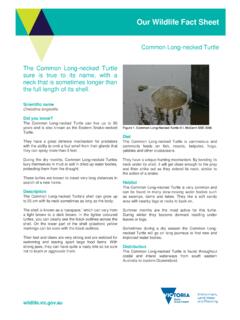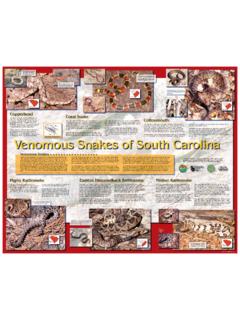Transcription of Red Bellied Black Snake - Wildlife - Wildlife
1 This Snake with its shiny Black skin and red underside is quite a sensation! Scientific name Pseudechis porphyriacus Did you know? The Red- Bellied Black Snake can sometimes give birth to up to 40 live snakes at one time. This species is not aggressive and will usually retreat before attacking, although when it is threatened it will raise its body from the ground flatten its neck, hiss and perform a series of strikes. There have been no recorded human deaths as a result of a Red- Bellied Black Snake bite to date in Australia.
2 Red- Bellied Black snakes enjoy feasting on frogs and the cane toad has been a problem for this species with its toxic venom destroying the Snake . This Snake is sometimes known to eat other snakes , including its own kind! Description The Red- Bellied Black Snake can grow up to m however adults usually average around m. The name of this Snake comes from its bright shiny Black with the underside consisting of creamy pink to a rich red. The snout is brown. This Snake is in the elapid family meaning it is venomous and like all venomous snakes it is front fanged.
3 Figure 1. Red- Bellied Black Snake I. McCann DSE 2008 Diet This species preys on frogs, rats, mice, lizards, birds, fish, eels and sometimes other snakes . They have a good swimming ability so can also feed on many aquatic species. Habitat The Red- Bellied Black Snake likes to reside near water bodies and can usually be found near river and creek banks, swamps and wet forests. snakes must regulate their body temperature externally by sunning themselves or retreating to cool, shaded areas. You can sometimes see them basking on a rock or underneath timber, rocks and abandoned burrows.
4 During the winter months snakes will hibernate. Our Wildlife Fact SheetRed- Bellied Black Snake Our Wildlife Fact Sheet The State of Victoria Department of Environment, Land, Water and Planning 2017 This work is licensed under a Creative Commons Attribution International licence. You are free to re-use the work under that licence, on the condition that you credit the State of Victoria as author. The licence does not apply to any images, photographs or branding, including the Victorian Coat of Arms, the Victorian Government logo and the Department of Environment, Land, Water and Planning (DELWP) logo.
5 To view a copy of this licence, visit Disclaimer This publication may be of assistance to you but the State of Victoria and its employees do not guarantee that the publication is without flaw of any kind or is wholly appropriate for your particular purposes and therefore disclaims all liability for any error, loss or other consequence which may arise from you relying on any information in this publication. Accessibility If you would like to receive this publication in an alternative format, please telephone the DELWP Customer Service Centre on 136186, email or via the National Relay Service on 133 677 This document is also available on the internet at Distribution The Red- Bellied Black Snake can be found all along the east coast of Australia, and northern parts of Victoria.
6 Figure 2. Recorded occurrences in Victoria Source: Victorian Biodiversity Atlas (records post 1979), version 15/05/2017 Breeding Mating occurs in the spring time. Males have been known to travel long distances in search of females. They are also known to fight over a potential mate. Their mating ritual consists of the male holding the female down with the head and twisting its tail around the females body. This process of reproduction can take anywhere from hours to days. This Snake is ovoviviparous meaning that it gives birth to live young, usually between 8 - 40 at one time.
7 What you can do to help! Remember that snakes are an important part of the ecosystem, reducing populations of overabundant pest species such as rats and mice. One of the biggest threats to the Red- Bellied Black Snake is cane toads, and numbers are greatly reducing in Northern Queensland as a result. Although problematic in Queensland there have been no known cases of cane toad issues in Victoria. If you want to reduce the chance of encountering a Snake around your home, you can modify the area to make it less desirable for snakes .
8 For example, keep grass very short and remove piles of rubbish and wood. Never attempt to move a Snake yourself. If there are unwanted snakes near your home, call DELWP s Customer Service Centre on 136 186 and ask for a list of Snake controllers in your area. These people are licensed to safely remove the reptile from the area. snakes are protected under the Wildlife Act 1975. Do not attempt to kill a Snake ; it is illegal and you are more likely to get hurt. Figure 3. Red- Bellied Black Snake I. McCann DSE 2008 Further reading Cogger, , (2000), Reptiles and amphibians of Australia (6th ed.)
9 , Reed New Holland, Sydney. Wilson, and Knowles, , (1988), Australia s reptiles, Collins, Sydney. Never attempt to approach or handle a Snake . All snakes should be considered venomous and highly dangerous If bitten by a Snake dial 000 immediately












